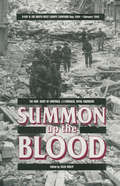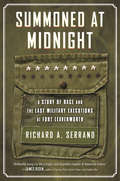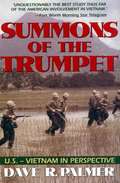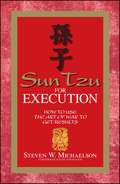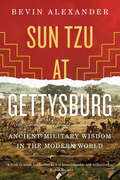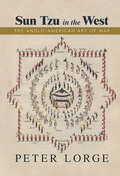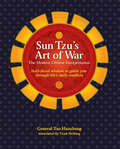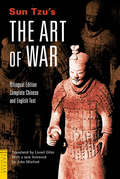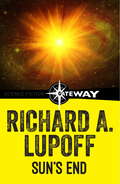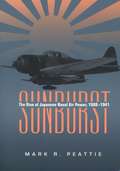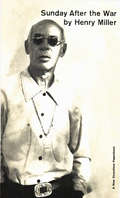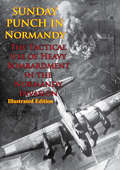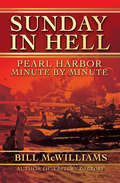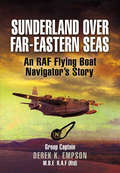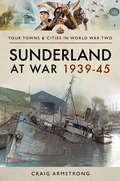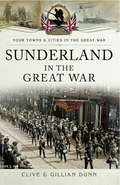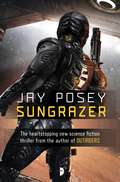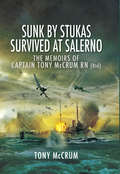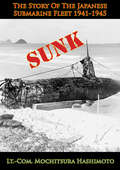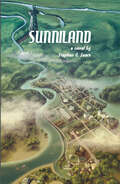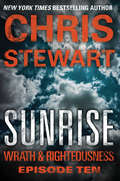- Table View
- List View
Summon Up the Blood: D Day & the North West Europe Campaign, May 1944-February 1945: The War Diary of Corporal J.A. Womack, Royal Engineers
by Celia WolfeA remarkable World War Two diary kept by Corporal Womack.
Summoned at Midnight: A Story of Race and the Last Military Executions at Fort Leavenworth
by Richard A. SerranoA lost history of racial discrimination in America's capital punishment system revealed by seventeen lives lived in the Fort Leavenworth military prisonBetween 1955 and 1961, seventeen condemned soldiers--eight white, nine black--lived together on death row at Fort Leavenworth military prison. All eight of the white soldiers were eventually paroled and returned to their families, spared by high-ranking army officers, the military courts, the White House staff or President Eisenhower himself, sympathetic doctors, and attorneys highly trained in capital litigation. One white master sergeant was serving time for drowning the eight-year-old daughter of an army colonel in Japan. But when the girl's parents forgave him, it sparked a national effort that opened the prison doors and set him free.During the same six-year period, almost every black soldier was hung, lacking the benefits of political connections, expert lawyers, and public support of their white counterparts. By 1960, only the youngest black inmate, John Bennett remained on death row. His battle for clemency was fought over the backdrop of a strengthening civil rights movement, and between two vastly different presidential administrations. With each year came a new legal twist, his freedom and his life hanging in the balance between evolving ideas and realities of race in America.Now, drawing on interviews, transcripts, and rarely-published archival material, Pulitzer Prize-winning journalist Richard Serrano uncovers the lost history of these unforgettable characters, the scandalous legal maneuvering that reached the doors of the White House, and the intimate history of the racism that pervaded the armed forces long after its integration.
Summons of Trumpet: U.S.-Vietnam in Perspective
by Dave R. PalmerSoldier/scholar Palmer traces the history of the American involvement in Vietnam and shows how events in both the U.S. and Vietnam became inextricably linked as domestic dissent and a lack of realistic, viable military strategy ultimately led to America's first lost war.
Sun Tzu For Execution: How to Use the Art of War to Get Results
by Steven W MichaelsonA Simon & Schuster eBook. Simon & Schuster has a great book for every reader.
Sun Tzu at Gettysburg: Ancient Military Wisdom in the Modern World
by Bevin Alexander"The world's most fascinating battles and how they were won or lost, according to the Chinese sage."--Kirkus Reviews Imagine if Robert E. Lee had withdrawn to higher ground at Gettysburg instead of sending Pickett uphill against the entrenched Union line. Or if Napoléon, at Waterloo, had avoided mistakes he'd never made before. The advice that would have changed these crucial battles was written down centuries before Christ was born--but unfortunately for Lee, Napoléon, and Hitler, Sun Tzu's The Art of War only became widely available in the West in the mid-twentieth century. As Bevin Alexander shows, Sun Tzu's maxims often boil down to common sense, in a particularly pure and clear form. When Alexander frames these modern battles against 2,400-year-old precepts, the degree of overlap is stunning.
Sun Tzu in the West: The Anglo-American Art of War
by Peter LorgeIt would be hard to overstate the impact of Sun Tzu's The Art of War on military thought. Beyond its impact in Asia, the work has been required reading in translation for US military personnel since the Cold War. Sun Tzu has been interpreted as arguing for 'Indirect Strategy' in contrast to 'Direct Strategy,' the latter idea stemming from Ancient Greece. This is a product of twentieth-century Western thinking, specifically that of Liddell Hart, who influenced Samuel B. Griffith's 1963 translation of Sun Tzu. The credibility of Griffith's translation was enhanced by his combat experience in the Pacific during World War II, and his translation of Mao Zedong's On Guerrilla War. This reading of Sun Tzu is, however, very different from Chinese interpretations. Western strategic thinkers have used Sun Tzu as a foil or facilitator for their own thinking, inadvertently engaging the Western military tradition and propagating misleading generalizations about Chinese warfare.
Sun Tzu's Art of War
by General Tao Hanzhang Tao HanzhangA classic! Find inspiration in some of history’s great military victories as others have for over 2,400 years. Sun Tzu was the most famous military scientist, and one of the ablest commanders, in ancient China. Asian warlords, and modern leaders as dissimilar as Mao Tse-tung and General Eisenhower, have used his principles to change the shape of the world. Interpreted here by General Tao Hanzhang, one of the architects of the Communist Revolution, Tzu’s advice on timing, maneuvering, flexibility, and knowledge of the enemy’s leaders, strengths, and weaknesses is as powerful today as when it was first issued.
Sun Tzu's The Art of War: Bilingual Edition Complete Chinese and English Text
by Sun Tzu Lionel Giles John MinfordSun Tzu's The Art of War has been the premier manual of Chinese military strategy for the past two millennia and, as thousands of Asian businessmen can attest, this classic work is as applicable to the corporate world as it is to the battlefield.<P><P>This is the only contemporary edition of the classic Lionel Giles translation to contain all of the translator's original notes, to help you better understand Sun Tzu's powerful maxims and apply them in your daily life. John Minford's foreword brings insights to this classic text and its timeless relevance to the modern world.This edition also marks the first time Giles' translation has been converted to Hanyu Pinyin--the standard Chinese romanization system. Additionally, the book contains the full Chinese language version of the text, along with Giles' extensive notes, with their original Chinese text references to the historical Chinese commentators, making this edition a treasure to military scholars, martial artists, and those planning to use Sun Tzu's strategies to conquer the business world.Sun Tzu's The Art of War will arm you with the knowledge that has allowed those who have studied this classic to gain victory--and often, total domination--over those who remain ignorant of its sage advice.
Sun's End: Sun's End Book 1
by Richard A. LupoffThe last thing computer circuit planner Daniel Kitajima remembered was being hit by a crane at an orbital construction site. Waking up 80 years later - in 2089 - he found that most of his body had been destroyed...but he had survived.A group of doctors had constructed an artificial body that gave him superhuman strength, the ability to survive without food or air, the powers of radar and infrared vision.All Daniel wanted was to resume a normal life. But his new-found strengths had attracted the attention of powerful people with a devastating secret - that the solar system only has a few centuries to live...
Sunburst
by Mark PeattieThis acclaimed sequel to the Peattie/Evans prizewinning work, Kaigun, illuminates the rise of Japanese naval aviation from its genesis in 1909 to its thunderbolt capability on the eve of the Pacific war. In the process of explaining the navy s essential strengths and weaknesses, the book provides the most detailed account available in English of Japan s naval air campaign over China from 1937 to 1941. A final chapter analyzes the utter destruction of Japanese naval air power by 1944.
Sunday After the War
by Henry Miller"I always carry over 40,000 gold francs about with me in my belt. They weight about 40 pounds, and I am beginning to get dysentery from the load." A collection of stories and excerpts from longer works.
Sunday Punch In Normandy - The Tactical Use Of Heavy Bombardment In The Normandy Invasion: [Illustrated Edition] (Wings at War #2)
by Anon[Illustrated with 5 photos and 7 maps]Originally published shortly after key air campaigns, the Wings at War series captures the spirit and tone of America's World War II experience. Eyewitness accounts of Army Air Forces' aviators and details from the official histories enliven the story behind each of six important AAF operations.Sunday Punch in Normandy focuses on the all-important invasion of Normandy, on June 6, 1944, forever remembered as "D-Day." Just before dawn, wave after wave of Army Air Forces heavy bombers targeted the beach areas to make way for the assault troops. The pilots encountered virtually no air opposition, because the massive Allied air superiority effort had been brilliantly planned and well-orchestrated.This short study describes in detail the close cooperation among the Allies in formulating the D-Day plan. A final section on operations gives a chronology of the interdiction missions flown by Eighth Air Force fighters and bombers.
Sunday in Hell: Pearl Harbor Minute by Minute
by Bill McWilliamsThe author of A Return to Glory constructs a compellingly detailed and panoramic history of the fateful day that ushered the United States into WWII. Using long-established historical records and contemporary journals, as well as recently released wartime documents, Bill McWilliams has created a brand-new minute-by-minute narrative of the Day That Will Live in Infamy. Told from the points of view of dozens of characters, from generals and admirals and politicians and diplomats down to deckhands and private soldiers and innocent civilians at all levels, this panoramic overview of one of the most traumatizing and shocking events in American history puts the reader in a position to understand the big picture of strategy and tactics, as well as the intimate details of what the chaos, violence, and presence of death felt like to people immersed in the surprise of an armed attack on American soil. December 7, 1941, was a turning point in the history of the United States, which had been teetering on a decision between isolationism and intervention. One might argue that every US military engagement since then has been affected by what happened when America learned that it could not stand by and watch war among strangers without potentially becoming involved—whether we wished to or not.
Sunderland Over Far-Eastern Seas: An RAF Flying Boat Navigator's Story
by Derek K. EmpsonThis is the first book to give a detailed, first-hand account of post-World War II RAF Short Sunderland operations in the Far East. The author was a navigator with 88 Squadron and later 205 Squadron, flying operations during the Korean War, the Malayan Emergency and many other operations. He was based at Seletar in Singapore, Kaitak in Hong Kong, Iwakuni near Hiroshima and various other operational bases throughout his two and a half year tour. The Sunderland flying boat was a unique aircraft in that each crew was allotted an aircraft which became their floating and airborne home. The crew relied upon all-round cooperation to keep the airplane in top condition, plus the addition of personalized luxuries. The task of long distance navigation in the Far East during the early 1950s relied on the conventional methods of astro navigation and dead reckoning, a difficult task when crossing hundreds of miles of open ocean and encountering monsoon and tropical storm conditions.Amongst the noteworthy events included is a return flight from Singapore to Hong Kong across 1,400 miles of ocean with a VIP passenger, his first operational flight as a 21 year old Pilot Officer navigator. He then undertakes an operation involving a return trip to Scotland which took three months. On moving to Kiatak the Sunderlands provided air cover for search and rescue operations, taking off and landing amongst the port's many small and erratically steered shipping craft. He flew sixty-one missions in support of the United Nations forces fighting in and around Korea, enduring the threat of Chinese fighters over the Yellow Sea. In one operation an engine fire caused the crew to ditch in the Tsushima Strait with serious structural failure and they were rescued by the USS De Haven, a US destroyer. This is a worthy record of some of the legendary Short Sunderland's final roles in the RAF.
Sunderland at War 1939–45 (Your Towns & Cities in World War Two)
by Craig ArmstrongThis local history explores the wartime contributions and sacrifices of a strategically significant English port town during WWII.Located on the River Wear, Sunderland was a vital hub for shipbuilding and coal exportation. During the Second World War, these important attributes marked it as a prime target for the Luftwaffe. The town experienced numerous air raids, including one which caused devastating casualties and structural damage. The authorities struggled to provide adequate shelters and Air Raid Precautions services.Sunderland also had a proud tradition of military service. Many joined the local Army regiment, the famed Durham Light Infantry, which saw action in almost every theater of the war. Other brave Wearsiders joined the Merchant Navy, the Royal Navy, and the Royal Air Force. Some served in Bomber Command, seeking vengeance for the brutal bombing of their home town.
Sunderland in the Great War (Your Towns & Cities in the Great War)
by Clive Dunn Gillian DunnLooks at how the Great War affected Wearsiders from the initial enthusiasm for sorting out the German Kaiser in time for Christmas 1914, to the gradual realization of the enormity of human sacrifice the families of Sunderland were committed to as the war stretched out over the next four years including local Zeppelin attacks and experiences of those fighting for the DLI and other regiments. The Great War affected everyone. At home there were wounded soldiers in military hospitals, refugees from Belgium and later on German prisoners of war. There were food and fuel shortages and disruption to schooling. The role of women changed dramatically and they undertook a variety of work undreamed of in peacetime. Meanwhile, men serving in the armed forces were scattered far and wide. Extracts from contemporary letters reveal their heroism and give insights into what it was like under battle conditions.
Sungrazer
by Jay PoseyIn a new Cold War between Earth and the colonies on Mars, when devastating weapons go missing, there’s only one team you can call – the Outriders. A crack force of highly specialised super-soldiers, their clone bodies are near-immortal. When a fully-autonomous vessel with orbital strike capabilities goes missing, it’s up to the Outriders to track the untrackable. But when the trail leads them to the influential Martian People’s Collective Republic, the operation gets a lot more complicated…File Under: Science Fiction
Sunk by Stukas, Survived at Salerno: The Memoirs of Captain Tony McCrum RN
by Tony McCrumTony McCrum was born in Portsmouth in 1919, the second son of a naval lieutenant and a mother who came from a line of naval officers that stretched back to and beyond Trafalgar. He entered the Naval College at Dartmouth in September 1932 and went on to complete his midshipmans time aboard HMS Royal Oak from 1936 to 1939.In January 1939 he shipped his first stripe to become an Acting Sub Lieutenant and joined HMS Skipjack, a fast fleet minesweeper, as navigator. The ship was initially based at Harwich as part of the 2nd Minesweeping Flotilla. Having worked-up to operational readiness the flotilla moved to their wartime station at Dover. In May 1940 Skipjack arrived off the Dunkirk beaches, one of the first ships to help the evacuation of the British Expeditionary Force. Having made several successful Channel crossings ferrying home troops, the French coast suddenly became even more dangerous as the Luftwaffe presence increased in support of their advancing army which had now reached the area. With a full load of troops aboard, Skipjack was suddenly attacked by ten Stukas and was mortally hit and sunk. Eventually rescue was at hand and McCrum was landed at Ramsgate. 19 of the crew and 294 troops went down with the ship. In June 1940 he was appointed First Lieutenant of HMS Bridlington, a new minesweeper of the same class as Skipjack. In June 1941 he joined HMS Mendip, a Hunt Class destroyer with the task of defending the east coast against e-boat attack. Then came a complete change when he was ordered to HMS Largs to become the Signals Officer in Charge. This was an ex West Indies banana boat that had been converted into a Landing Craft Headquarters Ship. Her task was to carry an admiral and general who would control all the forces in the early days of an assault. In April 1943, Largs arrived in North Africa and began preparations for the Sicily landings. Operation Husky started on 8 July and proved a complete success with a bridgehead being established within hours. The next step was Italy, the Salerno landing. McCrum was again heavily involved with the HQ planning staff and the US Navy and was in charge of the ULTRA operations within the area. Salerno proved to be a much harder battle and was well defended. Having spent eighteen months working in the Mediterranean theatre, and various landings in France, McCrum was ordered home and joined the destroyer HMS Tartar on 15 January 1945 as Staff Signals Officer, 8th Destroyer Flotilla. They were bound for the Far East and the war with Japan and it was there, in Trincomlee harbor that the end of WWII was celebrated.
Sunk: The Story Of The Japanese Submarine Fleet 1941-1945
by Lt.-Com. Mochitsura HashimotoWhat happened to Japan's submarines and what sort of fight did they put up?As far as Japan was concerned, the recent war was waged according to a rigid strategy. There was no detailed operational planning. It was a fight in which science had been ignored. In such circumstances the submarine, always highly vulnerable unless used intelligently, was inevitably sacrificed. Throughout the war the whole submarine fleet was in reality a special attack force in which, in the absence of scientific weapons, the crews were just so much human ammunition. Today we hear much about rearmament. If money is to be spent on armaments, it should be used for scientific development. Never again must we go to war with only a bamboo lance.The Japanese Submarine Fleet was entirely wiped out, but the martial spirits of its sailors are still with us on the far-flung oceans. In the Pacific, the Indian Ocean, and the Atlantic we remember the multitude of resentful sleeping warriors; in our ears we hear the whisper of the "voice from the bottom of the sea."Thus, as one of the few submarine captains to survive, I have taken up my pen to try to record something of the unknown hardships and successes of our submarines."Despite the gloomy conditions under which they worked, our submarines fought well, and the grim story of Japanese submarine units has been well recorded by former Lieutenant Commander Hashimoto."It is certainly valuable material, and I wish to recommend it as an excellent history."--S. Toyoda, Former C.-in-C., Combined Fleet, IJN
Sunlight Hours: Three women united by the secrets of a river . . .
by Caroline CaugantThirty-something Parisian artist Billie is working towards her next exhibition when she receives the news that her mother, with whom she has had no contact for years, has drowned in the river near her nursing home. In an attempt to understand the circumstances of her death, she returns to V, the village where she grew up in the parched, sun-drenched hills above the Mediterranean. When she arrives there, Billie finds herself reliving memories of another river drowning, 20 years earlier, memories she had tried to obliterate. What happened to Billie's dear friend Lila back then, at the age of 16, and why is Billie stalked by guilt? Sunlight Hours paints a picture of three generations of women, united by the secrets of a river.
Sunlight Hours: Three women united by the secrets of a river . . .
by Caroline CaugantThirty-something Parisian artist Billie is working towards her next exhibition when she receives the news that her mother, with whom she has had no contact for years, has drowned in the river near her nursing home. In an attempt to understand the circumstances of her death, she returns to V, the village where she grew up in the parched, sun-drenched hills above the Mediterranean. When she arrives there, Billie finds herself reliving memories of another river drowning, 20 years earlier, memories she had tried to obliterate. What happened to Billie's dear friend Lila back then, at the age of 16, and why is Billie stalked by guilt?Sunlight Hours paints a picture of three generations of women, united by the secrets of a river.
Sunniland
by Stephen O SearsFaced with guilt and uncertainty, a young geologist travels to Florida in the spring of 1943 to monitor the development of a new oil well while facing a German U-boat rampage taking place in the nearby Gulf of Mexico.During 1942 and 1943, German U-boats sank over one hundred tankers in the Gulf of Mexico and the Caribbean Sea, blocking the flow of crude oil to the refineries in the northeastern US. In response, the American government encouraged drilling in South Florida, resulting in the discovery of oil by a wildcat well in the Florida Everglades. And during this time, four German saboteurs landed by U-boat in Florida, and were caught and subsequently executed. These apparently unrelated and largely forgotten historical facts are the backdrop for the extraordinary adventure of Jerry MacDonald, a young geologist who travels south from Manhattan to Florida with his wife, Maria, in the spring of 1943. MacDonald has been dispatched to interpret the geological findings as a wildcat well is drilled in the wilderness of southwest Florida. Faced with constant questions about his civilian status while his contemporaries are joining the Armed Forces, guilt and uncertainty comingle with the pleasure of a trip to an exotic location. Jerry and his wife Maria arrive at the small town of Everglades City to find an isolated village that exemplifies the culture of the Deep South in the middle of the twentieth century. The challenges of setting up a drilling rig in the marshy terrain of the Everglades and spudding a wildcat well preoccupy Jerry, while Maria finds work as a bartender in the Turner Hotel. As the well is drilled, the German U-boat rampage taking place in the nearby Gulf of Mexico violently collides with the lives of the MacDonalds, the drilling crew, and the inhabitants of the Everglades.
Sunnybrook Hospital: Our Veterans’ Legacy of Care, a Photo Journey Through the Decades
by Peeter A. PoldreWhen Alice M. Kilgour donated her family farm to the City of Toronto in 1928, intending it for use as a public park, no one could have imagined what lay ahead. Ownership of the land was transferred to the Canadian government in 1943. By 1948, Sunnybrook Hospital opened its doors and became the largest veterans’ hospital in Canada. More than 60 years later, Sunnybrook stands as an important symbol of Canada’s gratitude toward its war veterans. Sunnybrook Hospital is a photo journey through the decades that chronicles the contributions of a dedicated group of health professionals and veterans and their tireless efforts to make the hospital what it has become over the years. Together they have set a remarkable standard in all fields of care, teaching, and research in an effort to honour Canada’s heroes.
Sunrise (Wrath & Righteousness #Episode Ten)
by Chris StewartVIRTUE & BLOOD <p><p> "Are we a moral people? Are we worthy of the fight? Is any of it worth fighting for? I'm here to tell you that it is. I love my country. I know you love it, too. Now it's time to man up and find the courage to join us in this cause." <p> As the final, dramatic episode begins, the future of America--and perhaps the freedom of all mankind--hang in the balance. Two men, one driven by Darkness, and the other by Light, are locked in a struggle for power that will change everything. <p> The former Secretary of Defense, realizing that he is the Republic's last chance, sends a trusted ally into his rival's heavily secured compound. Her mission: to retrieve one of three living members of the Supreme Court and bring him out to join his colleagues and rule on the presidential line of succession. <p> If she is successful, there is no guarantee the Justices will rule in their favor. And if she fails, there is no back-up plan. <p> Against the backdrop of torn-from-the-headlines Middle Eastern drama, the Wrath & Righteousness series is a fast-paced thriller that explores man's role in the eternal battle between good and evil. <p> Chris Stewart, a world-record-setting Air Force pilot (fastest nonstop flight around the world), is the New York Times bestselling author of several books, including The Miracle of Freedom
Sunrise Canyon (The New Americana Series #1)
by Janet DaileyIn Arizona&’s desert, a girl who needs her father, a woman who needs forgiveness, and a war hero who needs healing form a family: &“Touching . . . well-written&” (Publishers Weekly). Before he left for Afghanistan, Jake O&’Reilly had everything—a beautiful wife, a baby on the way, a wonderful life. Three years later, his wife is dead and he is so haunted by his memories of war that he can&’t bring himself to go home. But when his wife&’s grandfather tracks him down and persuades him to come work on his ranch, where Jake&’s daughter is living, he agrees—even though he is reluctant to expose his little girl to the man he&’s become. At Flying Cloud Ranch, his daughter doesn&’t even recognize this brooding stranger. But the beauty of the ranch and the immediate connection Jake feels with his wife&’s cousin Kira slowly begins to heal his wounds. Though he doesn&’t want any complications, he finds himself impossibly drawn to the tough woman who runs a horse therapy program for troubled teens. And as they each begin to imagine a new future, they discover that happily ever after is always within reach—if only you are willing to open your heart . . . PRAISE FOR NEW YORK TIMES–BESTSELLING AUTHOR JANET DAILEY and her novels &“Big, bold, and sexy . . . Janet Dailey at her best!&” —Kat Martin on Texas True &“Dailey fans will be delighted by Texas True. The gallant and charming Tyler brothers won&’t soon be forgotten.&” —RT Book Reviews (4 stars) &“Dailey confirms her place as a top mega-seller.&” —Kirkus Reviews
